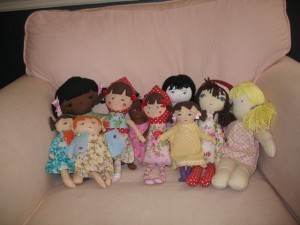Anna Elliott's Blog, page 2
October 31, 2012
Princess Mama
I have a ring, a $5 cubic zirconia ring that I wear exclusively because it is (along with the emergency mini-boxes of raisins and sticks of sugar-free gum in my purse) part of my bag of tricks for when I’m stuck in traffic or waiting in line with my girls. Look! You can wear my ring! is usually good for 10-15 minutes of entertainment value at such times. (I’m pretty sure that there’s a codicil to Murphy’s Law which states that if you loan your children your real engagement ring, they will drop it down the car seat cushions, forcing you to spend an hour ripping the car apart to find it. That $5 CZ ring? Has not been so much as misplaced. Not even once.)
Now, Vivienne, my youngest, is very into asking me ‘why’. I know most children go through the ‘why’ phase sometime between 2 and 3–but for her it started before she turned 2 and now at just-turned-3 shows no signs of passing, such that I’m starting to think of it as more of a personality trait. She is just a girl who always wants to know the whys and wherefores of most every detail of our lives. So. The other day in the car, she asked me, “Mama, why do you have your ring?” And I, in that I-am-simultaneously-concentrating-on-crazy-traffic-and-wondering-what-to-cook-for-dinner-and-have-approximately-three-spare-brain cells-to-come-up-with-a-satisfying-answer, said, completely off-the-cuff: “So that I can pretend I’m a princess.”
Well. It’s so funny and completely unpredictable what will make a big, lasting impression on your kids. My off-the-cuff answer made a HUGE impression on Vivi. She now refers to the ring with wide-eyed-wonderment as my ‘princess ring.’ Which the other night resulted in this exchange, when I was called in to help her in the bathroom. (Apologies in advance for the mild bathroom humor; this was just way too funny not to share).
Vivi, catching sight of my ring: Oooh, Mama, are you pretending to be a princess right now?
Me: Yep, that’s right. In fact, you should probably start calling me ‘Princess Mama’
Vivi, apparently following a script sent directly from the gods of comedic punchlines. And no, I swear I am not making this up: Princess Mama, can you wipe my bottom?
And that, my friends, is the great, quintessential truth of motherhood: pretend you’re a princess all you want, but the–ahem–job description remains pretty much the same. And really, I wouldn’t have it any other way. I may not exactly love all parts of the job equally, but I do love that every part of the job is mine. And hey, occasionally getting called Princess Mama never hurt anyone. 
September 27, 2012
Governesses, Gold Diggers, and Great Ladies: The Roles of Women in Jane Austen’s Novels
I was thrilled to be asked to take part in a roundtable discussion with Patrice Hannon and Tracy Kiely, two fellow writers of Jane Austen-inspired works as part of the Austenesque Extravaganza going on now. We had an e-mail conversation about the roles of women in Jane Austen’s novels, which you can read below. Part I of our conversation is here.
Patrice Hannon: Emma is certainly punished for her (selective) snobbishness regarding her friendly neighbors, the Coles, when she fears she’ll be left in “solitary grandeur” on the night of their party. It’s worth noting that one of Austen’s best friends was Anne Sharp, governess to her brother’s children. Anne Elliot’s noble cousins are “nothing” to Anne because they possess “no superiority of manner, accomplishment,or understanding.” How much more there is to admire not only in Mrs. Weston but Jane Fairfax, who narrowly escapes ending up as a governess herself. Both are rewarded–and rescued–with good marriages. To say nothing of Elizabeth Bennet!
Anna Elliott:
That’s an interesting point you raise with the issue of characters being ‘rescued’ by good marriages. Austen gives Jane Fairfax and others happy endings–but she also gives us a glimpse of the darker side of women’s place in society, it seems to me, by showing what can happen to a single woman if there is no such good marriage option available. The poverty of the Miss Bates’ . . . and then there’s Charlotte Lucas, who might well have turned into a Miss Bates figure in old age if not for her marriage to the pompous and pretty much dreadful Mr. Collins. Elizabeth Bennet condemns her for marrying Mr. Collins. But did Jane Austen herself condemn Charlotte’s choice? I’m not so sure.
Tracy Kiely: I would actually disagree that Jane awarded Jane Fairfax with a good marriage. Frank Churchill is not a nice man, in my opinion. He not only toyed with Emma’s affections all while secretly engaged to Jane, but he openly flirted with Emma in front of Jane. One could make the argument that Jane is showing what happens when a woman is so well-mannered that she loses her sense of self. I don’t think any of Jane’s heroines would have tolerated such behavior from their future husbands. With Jane Fairfax, I think Jane Austen is advising women to stand up for themselves and demand to be treated with respect. All Jane Fairfax won with her demure manners and polite ways was a husband who didn’t take his commitment very seriously.
Patrice Hannon: Of course, Frank is no Mr. Knightley just as Jane is not the heroine, but she does stand up for herself in the end, and there’s every indication—as Mr. Knightley says—that once they’re married his character will improve under her influence. That character is flawed, to be sure, but he’s rich, handsome, witty, charming, and in love with her—as she is with him. Given the alternative, I think Jane Fairfax has done well, though not as well as Emma.
As you suggest, Anna, although Elizabeth Bennet can’t feel the same way about Charlotte Lucas once she agrees to marry Mr. Collins, I think Austen was more sympathetic (though in life she couldn’t make the same compromise herself, that is, to marry without love). She saw how terrible Charlotte’s choice was—to marry an unappealing man and have her own comfortable establishment, staying as far away from her husband as reasonably possible, or to remain single forever (being plain and on the shelf) and suffer the fate of an utterly dependent woman, to be a spinster, an unwelcome weight on her family forever. There’s a conversation in the wonderful fragment The Watsons that shows this very debate between Emma Watson and her sister. I love when Emma Watson says she would rather be a teacher at a school than marry a man she didn’t love, and her sister’s retort is basically that Emma has never been at school or she wouldn’t say such a thing so glibly. Austen’s heroines hold very high-minded romantic views on the subject, but I do think Jane herself was more understanding of a young woman like Charlotte’s predicament.
Anna Elliott:
Patrice, that’s the view of Frank Churchill that I’ve always had, too.
Though Tracy definitely puts an interesting slant on it, I’m going to
have to give that some thought. Would Frank Churchill have turned into a
Wickham or a Willoughby, given other circumstances? It’s very interesting
to theorize about the way Jane Austen’s life and her own romantic history
fueled the stories and characters she created. Speaking of, do either of
you have theories about the mystery man whom Cassandra claimed was about
to be engage to Jane, but died? Did he even really exist?
Tracy Kiely: I agree that Charlotte is depicted as a woman between a rock and a hard place. She doesn’t want to be dependent on her family,
but then deep down she doesn’t want to be married to Mr. Collins either. (And who would?) For the longest time, I thought that she was making the best of a bad
situation, but then, upon my sixth or seventh reading, it struck me of the impact of Charlotte’s bad mouthing of Lydia and Mr. and Mrs. Bennet’s parenting skills to Mr. Collins. He runs with the story to Lady Catherine – as he does with everything – and then Lady Catherine spreads the story further. It’s even implied by Mr. Collins that the three of them discussed the matter.
“And it is the more to be lamented, because there is reason to suppose as my dear Charlotte informs me, that this licentiousness of behaviour in your daughter has proceeded from a faulty degree of indulgence; though, at the same time, for the consolation of yourself and Mrs. Bennet, I am inclined to think that her own disposition must be naturally bad, or she could not be guilty of such an enormity, at so early an age. Howsoever that may be, you are grievously to be pitied; in which opinion I am not only joined by Mrs. Collins, but likewise by Lady Catherine and her daughter, to whom I have related the affair. They agree with me in apprehending that this false step in one daughter will be injurious to the fortunes of all the others; for who, as Lady Catherine herself condescendingly says, will connect themselves with such a family?”
That bugged me, I must admit, as it seemed disloyal to Elizabeth. I wondered if Charlotte was a good friend stuck with a bad decision or a bit more mercenary than previously realized. Did anyone else think this?
Patrice Hannon: I think perhaps Charlotte’s being—by her own admission–“not romantic” adds to that impression of her being repulsively calculating in her “prudent” behavior. Now that Mr. Collins is her husband, it’s not terribly surprising that while discussing the scandal she expresses to him an opinion about the Bennets’ parenting that is in line not only with Elizabeth’s own but also the narrator’s. She’s not really criticizing Elizabeth and she certainly never expected to have her words repeated in this way–and no doubt enhanced by the speaker. It does make me queasy to think of her having “pillow talk” with Mr. Collins! But I think still Austen can sympathize with Charlotte’s position even while showing her less appealing qualities. There are very few characters in all of Austen who are wholly admirable—“spotless as an angel,” like the ones in Catherine Morland’s beloved novels.
That is one hilarious passage, though.
As for your question, Anna, the hard facts are so few in the report of Jane’s Devon lover that it’s difficult to say what actually transpired but the notion that she met this man at a seaside resort certainly adds to the romantic haze surrounding the story. Whenever Austen writes about the seaside you can just feel her pleasure and passionate admiration. It’s little wonder Lyme is one of the settings in her most romantic novel!
Speaking of Persuasion, to me one of the most interesting female characters in all of Austen is Mrs. Croft. I love how she’s described as looking as intelligent and keen as any of the naval officers. Her life is extraordinarily different from that of other women in the novels. She’s seen a great deal of the world. There’s such a refreshing sense of freedom and independence in her speech and activities, while at the same time she’s thoroughly attached to her husband, an equal partner. No wonder Anne, so tired of vanity without pride, cold formality, preoccupation with position, plain stupidity and her own dependence is bewitched by such a picture of how differently a woman might live.
Anna and Tracy, thank you for a most stimulating discussion!
June 19, 2012
Survey Results and Promises
Thank you so much to the literally dozens of people who are submitting responses to my Demon Hunter & Baby survey every DAY. I never expected when we posted the survey to get so many votes, but I am having SO much fun reading everyone’s answers. Seriously. It’s one of those facts of being an author that I’ll never meet or even know the names of 99% of the readers who encounter my books. Which is cool in its way–I mean, once I release a story into the world, it’s no longer ‘mine’, it belongs to readers, not to me. But I still really, really love the chance to hear reader’s feedback and responses.
Even if it’s not bringing me any closer to settling the Rafe/Kieran debate!  So far, the scales are tipped slightly in Rafe’s favor, but Kieran definitely has a sizeable share of the vote, and equally passionate pleas have been made on both sides. But anyway, while I can’t make any promises as yet as to who Ash will end up with, the survey has raised some other really, really good reader questions that I CAN in fact make promises about.
So far, the scales are tipped slightly in Rafe’s favor, but Kieran definitely has a sizeable share of the vote, and equally passionate pleas have been made on both sides. But anyway, while I can’t make any promises as yet as to who Ash will end up with, the survey has raised some other really, really good reader questions that I CAN in fact make promises about.
Firstly, I had one plea to ‘keep the series clean’, from someone who appreciated the fact that there is no profanity or sex in the book. Now, this is a tricky issue because as an author I can see that there are stories in which sex and bad language have a necessary and completely non-gratuitous place–and I would certainly NEVER condemn another author for feeling that those elements are needed in whatever story he/she is telling. However, I can promise you that sex and profanity do NOT have a place in Aisling and Willow’s story and never will. The language will always be clean and there will not be anything steamier than kissing. Promise.
Secondly, I had one reader ask that I not make either Kieran or Rafe turn annoying or unlikeable just so that Aisling’s choice would be made ‘easier’. To which I answer: absolutely. That’s an easy promise to make. Not to be super-critical, but I really, really hate the variety of storytelling where characters change personalities as rapidly as normal people change socks, just for the sake of making the author’s job easier. Kieran and Rafe are both (at least I think so!  ) good guys and will remain so, whichever one of them Ash picks in the end.
) good guys and will remain so, whichever one of them Ash picks in the end.
And lastly, I’ve had more than one response that asked that whichever one of the men in her life Ash doesn’t pick ought to wind up with a new love interest of his own. Now, this is something I can’t necessarily make an absolute promise about since I haven’t gotten that far in the planning of the series. (I mean, kind of contingent on knowing which guy Ash does end up with before I write in a love interest for the other one). However, I will say that it’s very, very likely. I really love romance and happy endings, and I really love both Kieran and Rafe, and I know I’ll want both of them to be in a happy place when the series comes to an end. Actually, there is a character introduced in Demon Hunter and Baby who was going to be a love interest for one of them . . . back when I knew which of them Ash was meant to be with. Now I’m not entirely sure, but that character is still there, and she’s someone I’m definitely excited to get to know better as the series progresses.
Anyway, I think that’s all. Thanks so much again, everyone, and keep those votes coming!
June 12, 2012
Updates!
I’ve had many emails asking me about paperback versions of my books, inquiring when Georgiana Darcy’s Diary and my other series’ will be available in paper as well as e-book form. And now I’m so excited to announce that–thanks to Mr. (amazingly awesome) Husband–the books now are. Go to Amazon or –especially for non-US readers– Book Depository and you can find the first two books of my Susanna and the Spy series as well as Georgiana Darcy’s Diary and it’s sequel. And my amazingly talented friend Laura Massellos’s drawings look SO incredibly gorgeous in the Georgiana paperbacks. She has done all original artwork for both Georgiana’s Diary and Pemberley to Waterloo, and I am so, so happy with the result. Thanks, Laura!
And next, for anyone who has read Demon Hunter and Baby, you know that Aisling, my heroine, is torn between the two men in her life: Kieran and Rafe. And so am I! Honestly, I started the series knowing exactly who Ash was meant to be with . . . and now I’m not so sure at all! I think I’m waiting for Ash to clue me in as I write the next books. But until she does, you can cast your vote! Go here and you can tell me who you think Ash should end up with! Can’t promise I will go with a majority rules or anything like that, but I definitely DO promise you that I am going to read and think about every response as I wait for Ash to make up her mind. And thank you to everyone who has responded so far!
April 19, 2012
Dolly Donations
My poor blog. 99% of the time, it sits here, staring at me plaintively, daring me to dream of a time when I won’t feel like I’m drowning in my life and have time to update it. Don’t get me wrong, it’s a happy kind of drowning, but . . .
However, I wanted to call attention to this for anyone that hasn’t heard about it because it is SUCH a lovely cause. Sarah runs a website called Dolly Donations, and posts about drives to send handmade dolls to children in need all over the world. In her words:
My mission is to make a difference in the lives of those less fortunate, especially orphaned children around the world ……. to provide them with a source of comfort …… to send them love, one dolly at a time!
I absolutely love this idea. And as it happens, one of my favorite hobbies–fueled on by my own sweet girlies–is sewing dolls. I just got this group of little ladies all packaged up to be sent off to children in Brazil.
Actually the donation pile has grown quite a bit since that photo was taken! Now we’re working on another group of dolls to be sent off to children in Rwanda. Sarah also has some links to great articles about the importance of dolls in a child’s life, how beneficial and comforting a doll can be in helping a child to cope in a time of stress. It’s so true! Any time my girls face something ’scary’ they immediately ask for a doll to hug.
Anyway–I can’t end hunger or bring about world peace. But I can certainly sew dolls and send them to children who need sources of comforting in their lives. Any sewers out there? Consider making a doll of your own to donate! It’s truly not hard (trust me, I am FAR from an expert seamstress) and such a great opportunity to make a difference in a child’s life.
February 20, 2012
London Calling
Thank you so much to everyone who has written to me asking when London Calling, the sequel to Susanna and the Spy, will be available! With any luck, it should be up and available for purchase within the week. I am incredibly excited to share the next chapter of Susanna and James' story!
And while I'm on the subject, I've had some people inquire when Kitty Bennet's Diary will be available. That release date is less definite, but I'm hoping it will be available sometime this summer.
Thanks so much again to everyone who has written me to say that they're eagerly looking forward to one of my books! It just makes my day to hear that, always!
June 30, 2011
A Quick Note
So, I don't normally google-stalkerishly track down every mention of my books on line (I'm not that author! I swear!) But I've just happened to bump into a couple of reviews of Georgiana that wished there were more of the story or that some of the threads left semi-hanging at the end were tied up . . . and I realized that I should make it clear that there WILL be more of the story! I'm at work on Georgiana Darcy's Diary, Volume II right now, in fact, and with any luck it should be available sometime this fall. There will be more of Edward and Georgiana's story, and all the loose plot threads will be tied up, I promise. And if they're not, I'll write a volume III! I'm having far too much fun living in Georgiana's world to stop writing anytime soon.
June 12, 2011
Spencers, Pelisses, and Reticules: the Fashions of Jane Austen’s World
One quick note before I begin: for anyone wanting to know more about the subject of my last post–the experiences of the women who lived with and followed the British Army during the Napoleonic Wars–I can recommend Following the Drum, by Annabel Venning. The book isn’t exclusively about the Regency era, but it’s still an excellent resource for anyone wanting to research the experiences of army wives and daughters in more depth.
And now on to the subject of fashion during Jane Austen’s time period, which was one of the most purely fun aspects of writing Georgiana Darcy’s Diary: getting to dress my characters in the gorgeous fashions of the day. Obviously entire books have been written on the subject of Regency fashions, so this isn’t intended to be a complete survey. This post is just to showcase a few of the images I looked at for inspiration when imagining Georgiana’s and my other characters’ clothes–and to give explanations of some fashion terms that modern readers may be unfamiliar with, since the diary format made it almost impossible to define them in the book.
Jane Austen was born on December 16, 1775, and during her lifetime saw a revolution in fashion almost as dramatic as the American and French Revolutions that also occurred while she was alive. Women’s fashions moved away from the old wide hooped silhouette of the Georgian period to a high-waisted, narrow silhouette. Here are two dresses typical of the Georgian era, the first actually from 1775, the year of Jane Austen’s birth. (For anyone who has already read Georgiana’s Diary, these are the kind of gowns I was imagining for Georgiana’s cousin Anne to wear to the masquerade ball.)
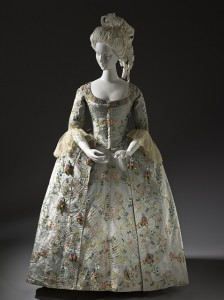
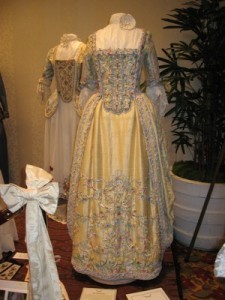
And here, in contrast, are some examples of Regency women’s fashions, the kind of images I looked at when dressing Georgiana and my other characters for evening parties and balls. You can see how the heavy silks and brocades of the earlier century gave way to delicate muslins with neoclassical details that were meant to emulate the democratic republics of the ancient world.
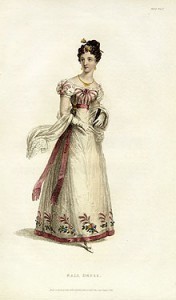
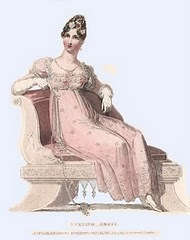

One of the early readers of Georgiana Darcy’s Diary asked me, “What is a pelisse?” It’s a very good question, since anyone unfamiliar with Regency fashions will probably never have heard the term. Briefly, a pelisse was an over garment similar to a coat, but with a high waist and long skirt to follow the line of the gown it was worn with. The thin, fashionable muslins were leaving ladies in need of an added layer of warmth in cold weather. Below is a picture of a pelisse that may have been worn by Jane Austen herself, followed by a fashion plate of the day.
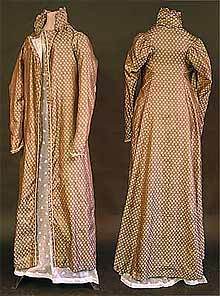
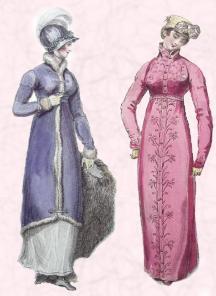
A spencer was another overgarment worn in chilly weather, but instead of following the lines of a high-waisted gown was a short fitted jacket only as long as the bodice. Spencers typically had long sleeves and a high collar, and often had military-style trimmings inspired by the army uniforms of the day.
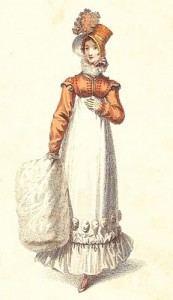
And lastly, a reticule was essentially the forerunner of the modern woman’s purse. During the Georgian era, skirts were wide enough and fabrics substantial enough that gowns could be sewn with inner pockets. But the thin, flimsy muslins and narrow skirts of the Regency left little scope for pockets, and so ladies began to carry reticules, small pouches like this one c. 1840: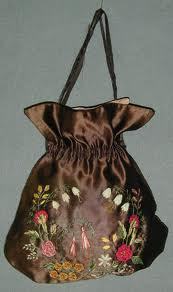
Reticules could be matched to the fabric of a gown, but many ladies preferred to make their own with beadwork or netting–which in fact Charles Bingley admiringly considers a mark of female accomplishment in Pride and Prejudice.
For anyone wanting to know more about Regency era fashions, I can highly recommend Fashion in the Time of Jane Austen, by Sarah Jane Downing.
Spencers, Pelisses, and Reticules: the Fashions of Jane Austen's World
One quick note before I begin: for anyone wanting to know more about the subject of my last post–the experiences of the women who lived with and followed the British Army during the Napoleonic Wars–I can recommend Following the Drum, by Annabel Venning. The book isn't exclusively about the Regency era, but it's still an excellent resource for anyone wanting to research the experiences of army wives and daughters in more depth.
And now on to the subject of fashion during Jane Austen's time period, which was one of the most purely fun aspects of writing Georgiana Darcy's Diary: getting to dress my characters in the gorgeous fashions of the day. Obviously entire books have been written on the subject of Regency fashions, so this isn't intended to be a complete survey. This post is just to showcase a few of the images I looked at for inspiration when imagining Georgiana's and my other characters' clothes–and to give explanations of some fashion terms that modern readers may be unfamiliar with, since the diary format made it almost impossible to define them in the book.
Jane Austen was born on December 16, 1775, and during her lifetime saw a revolution in fashion almost as dramatic as the American and French Revolutions that also occurred while she was alive. Women's fashions moved away from the old wide hooped silhouette of the Georgian period to a high-waisted, narrow silhouette. Here are two dresses typical of the Georgian era, the first actually from 1775, the year of Jane Austen's birth. (For anyone who has already read Georgiana's Diary, these are the kind of gowns I was imagining for Georgiana's cousin Anne to wear to the masquerade ball.)


And here, in contrast, are some examples of Regency women's fashions, the kind of images I looked at when dressing Georgiana and my other characters for evening parties and balls. You can see how the heavy silks and brocades of the earlier century gave way to delicate muslins with neoclassical details that were meant to emulate the democratic republics of the ancient world.



One of the early readers of Georgiana Darcy's Diary asked me, "What is a pelisse?" It's a very good question, since anyone unfamiliar with Regency fashions will probably never have heard the term. Briefly, a pelisse was an over garment similar to a coat, but with a high waist and long skirt to follow the line of the gown it was worn with. The thin, fashionable muslins were leaving ladies in need of an added layer of warmth in cold weather. Below is a picture of a pelisse that may have been worn by Jane Austen herself, followed by a fashion plate of the day.


A spencer was another overgarment worn in chilly weather, but instead of following the lines of a high-waisted gown was a short fitted jacket only as long as the bodice. Spencers typically had long sleeves and a high collar, and often had military-style trimmings inspired by the army uniforms of the day.

And lastly, a reticule was essentially the forerunner of the modern woman's purse. During the Georgian era, skirts were wide enough and fabrics substantial enough that gowns could be sewn with inner pockets. But the thin, flimsy muslins and narrow skirts of the Regency left little scope for pockets, and so ladies began to carry reticules, small pouches like this one c. 1840:
Reticules could be matched to the fabric of a gown, but many ladies preferred to make their own with beadwork or netting–which in fact Charles Bingley admiringly considers a mark of female accomplishment in Pride and Prejudice.
For anyone wanting to know more about Regency era fashions, I can highly recommend Fashion in the Time of Jane Austen, by Sarah Jane Downing.
June 7, 2011
Following the Drum: Women in Wellington’s Army
One of my favorite aspects of writing historical fiction is the research. Learning the details of daily life in bygone eras, how men and women dressed, what they ate, how they traveled and what books they might have read. Most of all, though, I love reading through the primary sources–diaries, letters, cookbooks, contemporary accounts–and actually hearing the voices of the women and men who lived in the time periods I write about.
Edward, one of the main characters in Georgiana Darcy’s Diary, is a Colonel in the army, which sent me on a mission to discover as much as I could about the British army during the Regency era. Though Jane Austen scarcely mentions it in her novels, England was at war with France through almost the whole of her life, often under serious threat of invasion by Napoleon’s forces. I read through general histories of the Napoleonic wars, of course. But for me the most fascinating and vivid accounts are those written by the soldiers themselves.
One of these accounts is titled, The Recollections of Rifleman Harris. Benjamin Harris was a young shepherd from Dorset who joined the army in 1802 and later joined the 95th Rifles Batallion. His Batallion was ordered to Portugal, where he fought against Napoleon’s armies and suffered almost unimaginable hardships. He speaks of starvation, of men falling dead of sheer exhaustion during the long forced marches of retreat from the enemy, of the terrible noise and fierce joy of battle. He recounts at last returning to England with his fellow surviving soldiers, saying, “Our beards were long and ragged; almost all were without shoes and stockings; many had their clothes and accoutrements in fragments, with their heads swathed in old rags, and our weapons were covered with rust; whilst not a few had now, from toil and fatigue, become quite blind.”
It’s an extraordinary picture of what it must have been like to be a soldier in the Napoleonic wars. But for me the most poignant accounts in Harris’ Recollections are those that detail the experiences of the women who traveled with the British army. On any campaign, a certain number of the men were permitted to bring their wives and children along, those who were to receive this privilege being chosen by lottery. (And it was a privilege, since those wives unable to accompany their men were given a small sum, but would have to house, feed, and support themselves and their children entirely on their own while their men were gone. They faced the very real possibility of starvation, the workhouse, or being forced into prostitution). On the campaign Harris writes of, though, the suffering of the women and children who ‘followed the drum’ as the contemporary expression goes, is absolutely heartbreaking. The whole of the army was starving and exhausted almost to the point of death; there could be no help for anyone who couldn’t keep up.
During one disastrous retreat across snow-covered mountains, Harris recalls, “I remember passing a man and woman lying clasped in each other’s arms, and dying in the snow. I knew them both; but it was impossible to help them. They belonged to the Rifles, and were man and wife. The man’s name was Joseph Sitdown. During this retreat, as he had not been in good health previously, himself and his wife had been allowed to get on in the best way they could in the front. They had, however, now given in, and the last we ever saw of poor Sitdown and his wife was on that night lying perishing in each other’s arms in the snow.”
Harris also writes: “About this period I remember another sight, which I shall not to my dying day forget; and it causes me a sore heart, even now, as I remember it. Soon after our halt beside the turnip field the screams of a child near me caught my ear, and drew my attention to one of our women, who was endeavouring to drag along a little boy of about seven or eight years of age. The poor child was apparently completely exhausted, and his legs failing under him. The mother had occasionally, up to this time, been assisted by some of the men, taking it in turn to help the little fellow on; but now all further appeal was in vain. No man had more strength than was necessary for the support of his own carcass, and the mother could no longer raise the child in her arms, as her reeling pace too plainly showed. Still, however, she continued to drag the child along with her. It was a pitiable sight, and wonderful to behold the efforts the poor woman made to keep the boy amongst us. At last the little fellow had not even strength to cry, but, with mouth wide open, stumbled onwards, until both sank down to rise no more.”
Other stories, though, are an incredibly testament to the human power of endurance. During this same retreat, Harris recounts: “One of the men’s wives (who was struggling forward in the ranks with us, presenting a ghastly picture of illness, misery, and fatigue), being very large in the family-way, towards evening stepped from amongst the crowd, and lay herself down amidst the snow, a little out of the main road. Her husband remained with her; and I heard one or two hasty observations amongst our men that they had taken possession of their last resting-place. The enemy were, indeed, not far behind at this time, the night was coming down, and their chance seemed in truth but a bad one. To remain behind the column of march in such weather was to perish, and we accordingly soon forgot all about them. To my surprise, however, I, some little time afterwards (being myself then in the rear of our party), again saw the woman. She was hurrying, with her husband, after us, and in her arms she carried the babe she had just given birth to. Her hausband and herself, between them, managed to carry that infant to the end of the retreat, where we embarked. God tempers the wind, it is said, to the shorn lamb; and many years afterwards I saw that boy, a strong and healthy lad. The woman’s name was M’Gwuire, a sturdy and hardy Irishwoman; and lucky was it for herself and babe that she was so, as that night of cold and sleet was in itself sufficient to try the constitution of most females. I lost sight of her, I recollect, on the night, when the darkness came upon us; but with the dawn, to my surprise, she was still amongst us.”
Incredible enough to be part of a novel . . . but Harris’ stories are entirely true, authentic voices from the past.

